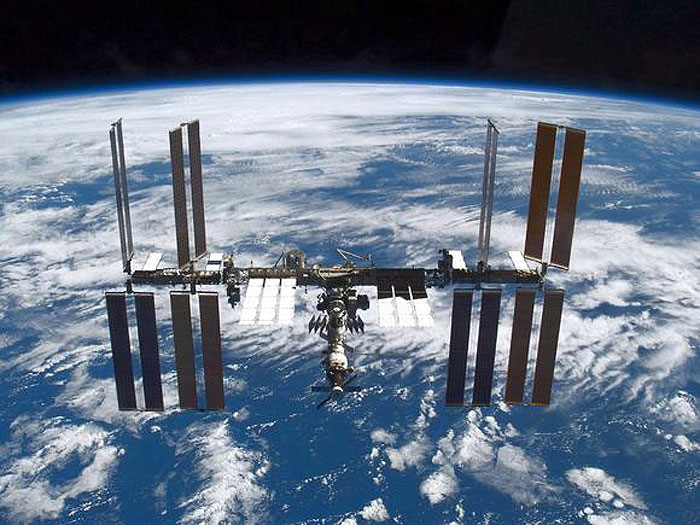.

WASHINGTON — The world's most expensive science project — the $100 billion-plus International Space Station — is poised to get four more years in orbit.
According to documents obtained by the Orlando Sentinel, NASA plans to announce this week that it has White House approval to extend the station's operations by four years until 2024.
The decision follows years of pressure by top NASA officials, who consider the station a critical steppingstone to future exploration. But a four-year extension likely would cost NASA about $3 billion a year from 2021 to 2024. That's a major chunk of the agency's annual budget, which is now about $17 billion, and a longer mission could force NASA to make tough financial decisions in the future.
The administration's approval, however, doesn't guarantee that the station, which has been continuously occupied since 2000, will survive past its current end date of 2020. At some point, Congress must approve a NASA budget that includes an extension of the station's life. The plan also must get the support of whoever wins the White House in 2016 — though the backing of President Barack Obama now might make it harder for the next administration to renege.
Still, the move is expected to reassure NASA's international partners, who have wondered how long the U.S. plans to commit to the station. NASA's announcement coincides with a visit to Washington this week by leaders of the world's space agencies.
Pictures: Orange County Jail Mug Shots
"Arriving at this decision in a timely and coordinated fashion will, hopefully, prove beneficial to our international partners as they struggle with decisions on funding for their space programs," NASA Chief Charlie Bolden wrote in an email to NASA and administration officials that praised the decision.
The announcement also has the potential of sending a signal to China, NASA's latest cosmic competitor.
In 2003, China become just the third country to launch an astronaut into space, and Beijing reportedly is making plans to assemble its own space station next decade.
By keeping the space station operational, NASA can maintain its own symbol of technical advancement while limiting attempts by the Chinese to woo global partners for its own outpost.
The symbolism is especially important for NASA because of the agency's recent struggles with its human-exploration program.
After NASA retired the space shuttle in 2011, the U.S. lost the ability to ferry its own astronauts to the station, which orbits about 220 miles above Earth. NASA is paying Russia about $1.7 billion through 2017 for the service.
Later this decade, NASA hopes to hire private "space taxis" to take on that responsibility while bringing those dollars back to U.S. companies. But it's unlikely those spacecraft will be ready before 2017.
Keeping the station going until 2024 gives these U.S. companies, including SpaceX of California, a chance to fly the NASA missions for several years. It's an economic boost that will help them compete with rival foreign rocket companies.
Central Florida also could benefit, with SpaceX flying cargo-resupply missions to the station from Cape Canaveral. Any extension of the station's life likely would result in the continuation of those flights.
NASA officials said they were confident they could keep the outpost aloft for years, despite occasional troubles such as a problem with the observatory's cooling loop that spacewalking astronauts had to repair last month.
"The structural margin of the ISS will be fully adequate to support ISS operations through at least 2028," wrote the authors of a December report that examined the issues involved in extending the life of the station.
Adding four years to the station also would help NASA and its partners recoup their investment in the station, because little science was done aboard the observatory in its early years.
"ISS is now in its most productive era of utilization for scientific research and technology demonstration …," noted the same NASA document.
As late as 2008, the crew averaged only three hours of science work a week. Now the six-member team is doing at least 50 hours weekly.
Research includes Earth observation, the study of cosmic rays and the effect of spaceflight on astronaut health.
Figuring out how space affects humans will be especially important if NASA ever plans an expedition to Mars, a round trip that likely would take years and expose space explorers to a wide variety of dangers, including radiation.
Astronauts have been doing shifts onboard the station for more than a decade — often in six-month intervals — and the outpost steadily has built a database of health history for space travelers.
Former NASA astronaut Leroy Chiao, who served as a space-station commander in 2004 and 2005, said the station is an invaluable tool in helping NASA find ways to combat bone loss, muscle atrophy and other ailments caused by spaceflight.
But he said some mysteries remain, including why some astronauts develop vision problems after extended stays in orbit.
"We still don't have a smoking gun for what causes that," he said. Chiao added that four extra years could help solve that problem, as well as a host of other scientific questions.
"I would hail this [announcement] as a big important step," he said.
.
Quelle: Orlando Sentinel
4516 Views
